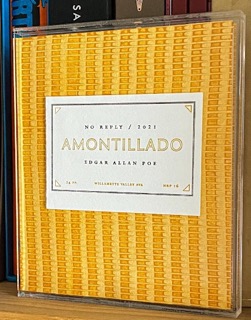The Cask of Amontillado: Summary, Plot, Characters, Literary Analysis & More
Crafted by the acclaimed American writer Edgar Allan Poe and originally published in Godey’s Lady’s Book in November 1846, “The Cask of Amontillado” weaves a web of suspense and psychological intrigue.
With an uncanny mastery, Poe takes readers on a journey into the depths of human motives and the darker aspects of the human psyche.
In this chilling short story, Montresor, a member of the affluent Montresor family, lures his acquaintance, Fortunato, into the depths of his family catacombs with the promise of the rare and elusive wine, Amontillado.
Beneath the veneer of conviviality lies Montresor’s hidden motive, setting the stage for a sinister plot of betrayal and revenge.
Poe’s gothic style and symbolic gestures transform the story into a haunting exploration of the complexities of trust, pride, and manipulation. Within this dark narrative, themes of deception, unreliable narration, and the blurred lines between reality and macabre are skillfully interwoven.
This analysis delves into the story’s intricate layers, unveiling the profound elements that have solidified “The Cask of Amontillado” as a timeless tale of human nature’s shadowy depths, showcasing Poe’s unparalleled ability to captivate and disturb readers in equal measure.
The Cask of Amontillado Summary
In “The Cask of Amontillado” by Edgar Allan Poe, the narrative unfolds with Montresor’s unsettling demeanor as he leads Fortunato, a wine connoisseur, into the eerie depths of his family catacombs.
With cunning manipulation, Montresor describes a rare Amontillado, enticing Fortunato’s pride and vanity. As they descend, Fortunato’s persistent cough contrasts with Montresor’s calculated calmness.
Amidst the catacombs, Montresor chains Fortunato to a wall, rendering him powerless. Fortunato’s initial bravado dissipates into silence, a stark contrast to Montresor’s steady resolve. Poe’s storytelling mastery is evident as he weaves the dark, gothic atmosphere that envelops the characters.
This short story delves into the themes of betrayal, revenge, and the unreliable narrator. Fortunato’s trust in Montresor becomes his undoing, showcasing the depths of human malevolence.
The tale stands as a testament to Poe’s ability to craft suspenseful narratives, leaving readers to ponder the sinister motivations hidden behind seemingly affable facades. As the chains of deception tighten, “The Cask of Amontillado” becomes a chilling exploration of the human psyche’s capacity for cruelty and manipulation.

In "The Cask of Amontillado" by Edgar Allan Poe, the narrative unfolds with Montresor's unsettling demeanor as he leads Fortunato, a wine connoisseur, into the eerie depths of his family catacombs.
Table of Contents
Summary The Plot Characters Key Themes Genres Language used Literary devices Summing upThe Plot
“The Cask of Amontillado” by Edgar Allan Poe unfurls a sinister plot where Fortunato, a wine enthusiast, is ensnared by Montresor’s calculated ploy. Montresor, swathed in his enigmatic coat, manipulates Fortunato’s pride by challenging him to verify a rare Amontillado within his family catacombs.
As they venture deeper into the damp darkness, Fortunato’s initial enthusiasm wanes, and he falls silent, puzzled by the chilling environment. This narrative exemplifies Poe’s penchant for macabre storytelling, seamlessly blending deception and suspense.
Fortunato’s challenges to Montresor’s claim lead him further into a labyrinth of doom. The tale mirrors Poe’s trademark gothic style, evoking a sense of unease that permeates his stories.
The sinister climax of Fortunato’s descent into silence and entrapment marks a haunting moment in literary history, cementing Poe’s legacy as a master of psychological horror.
Characters
Now, let’s explore the protagonists in Poe’s work.
Montresor
- A wealthy family member with a veneer of affability.
- Conceals his malevolent intentions beneath a carefully crafted facade.
- Wears an enigmatic coat that adds to his mystique.
- Expertly manipulates Fortunato’s vanity and challenges.
- His actions exemplify the themes of betrayal and revenge recurrent in Poe’s stories.
Fortunato
- A wine connoisseur who is lured into Montresor’s trap.
- Falls silent as he descends into the catacombs, marking a turning point.
- Arrogance and pride make him vulnerable to Montresor’s machinations.
- Challenges Montresor’s claims, unknowingly sealing his own fate.
- Serves as a vessel for exploring the darker aspects of human nature in Poe’s narratives.
Amontillado
- A rare and coveted wine, the supposed catalyst for Fortunato’s downfall.
- Symbolizes Fortunato’s vulnerability and naivety in trusting Montresor.
- Its allure serves as a manipulative tool to draw Fortunato into the catacombs.
- Acts as a catalyst for the unfolding tragedy and deception in the story.
- The pursuit of the Amontillado underscores themes of obsession and manipulation.
Montresor’s Ancestors
- Although not directly depicted, their legacy of vengeance drives Montresor’s actions.
- The grudge and family history set the stage for the twisted revenge plot.
- Reflects the themes of generational trauma and the weight of family honor.
- Montresor’s actions are, in part, an attempt to avenge perceived wrongs against his lineage.
- Their specter heightens the atmosphere of the story, adding to its gothic elements.
Key Themes
Edgar Allan Poe’s “The Cask of Amontillado” is rife with themes that intricately shape the narrative.
The tale is a masterclass in manipulation and vengeance, where Fortunato begins as a confident figure, symbolizing hubris. When he dons a jester’s costume, his vulnerability is heightened, foreshadowing his impending downfall.
The serpent Montresor describes subtly represents Fortunato’s temptation, while his uncontrollable laughs accentuate his naivety. Montresor mocks Fortunato, using bells to heighten his unease. The tale climaxes as Montresor confesses, revealing his calculated cruelty.
Fortunato’s journey into the catacombs mirrors his descent into darkness, while Montresor’s underlying foot motif represents his manipulative steps. The story, a quintessential Poe story, explores how Fortunato ultimately mocks and unwittingly hurts Montresor, prompting a cold-blooded act of revenge.
As Fortunato sobers, reality dawns on him, and Montresor’s distorted perception manifests through his twisted actions, revealing the theme of deception.
The characters themselves become symbols: Fortunato represents arrogance, while Montresor embodies vengeance and moral ambiguity, their actions blurring the lines between right and wrong. Montresor’s chilling final lines highlight the lingering power of revenge and the haunting consequences of deceit.
Genres in The Cask of Amontillado
The story navigates multiple genres, enriching its narrative. Primarily a gothic horror, the story conjures an eerie atmosphere through dark settings and psychological tension.
It also embodies elements of psychological thriller, delving into the manipulative psyche of Montresor and the vulnerability of Fortunato. The seamless blend of these genres magnifies the suspense, unease, and intricacies of the plot, creating a haunting tale that lingers in the mind of the reader.
Language used in The Cask of Amontillado
In “The Cask of Amontillado” by Edgar Allan Poe, the author’s distinctive style engulfs readers in an atmospheric tapestry. Through Poe’s stories, he crafts a narrative where emotions simmer beneath the surface.
As Fortunato falls silent, the language deepens the sense of impending doom. The author skillfully intertwines words, exemplified when Fortunato challenges Montresor’s claim, creating an air of suspense.
The vivid imagery, such as Montresor’s enigmatic coat, evokes an eerie ambiance, making every sentence a brushstroke that paints the chilling portrait of betrayal and revenge.
Literary devices in The Cask of Amontillado
In the story literary devices intricately shape the narrative. Montresor’s motives are enshrouded in mystery, driving the suspense. Montresor’s coat serves as a symbolic motif, concealing his hidden intentions.
The haunting specter of Fortunato’s grave accentuates the theme of revenge. The story employs irony as Fortunato unwittingly accompanies Montresor’s claims, leading to his demise. The tale is a mosaic of dramatic irony as the reader anticipates Fortunato’s murder, contrasting with his obliviousness.
Poe’s meticulous word choice and pacing enhance the chilling atmosphere in this gothic story. Fortunato’s desperate plea and subsequent silence evoke pathos. The moment Montresor meets Fortunato marks the inception of a malevolent plan.
The allure of Amontillado wine becomes a symbol of impending doom, while Fortunato’s costume underscores his vulnerability.
Similes
Similes play a vital role in deepening the story’s impact. Montresor’s claim about the Amontillado is likened to “medoc” – a comparison demonstrating his calculated deception. When Montresor demonstrates his wine expertise, his act is compared to that of a connoisseur, further emphasizing his deceitful mastery.
Fortunato’s journey towards his demise is paved with similes that foreshadow his doom, intensifying the ominous mood. The simile “mask of black silk” aligns with Montresor’s masked motives, underlining his hidden agenda.
The similes involving “friend Fortunato” and “insidiously” enhance the sinister nature of Montresor’s intentions. As Fortunato’s curiosity grows, he asks with “eagerness,” a simile underscoring his vulnerability.
Through these similes, Poe delves into the psyche of Fortunato, revealing his impending downfall. Ultimately, Montresor’s unreliability as a narrator, illustrated through various similes, creates a discordance between his words and actions.
Fortunato’s final words become chillingly vivid as they morph into his death sentence, mirroring his destiny. Similes paint a vivid picture of the story’s ominous journey, culminating in the unveiling of Fortunato’s grave, an image that lingers long after the tale’s end.
Metaphors
In “The Cask of Amontillado” by Edgar Allan Poe, metaphors enrich the narrative, delving into profound layers. Montresor’s coat, a metaphor for his hidden motives, cloaks his sinister intentions. As Fortunato dons a jester’s attire, his vulnerability is heightened, serving as a metaphor for his impending doom.
The metaphorical serpent represents Fortunato and his temptation, symbolizing his susceptibility to manipulation. His ominous laughter becomes a metaphor for his naivety, echoing his tragic fate.
These metaphors encapsulate deeper meanings, adding to the story’s allure by infusing characters and events with allegorical dimensions.
Analogies
Here, analogies intricately illuminate intricate concepts. As Fortunato’s insult hurts Montresor, it’s akin to a sharp blade piercing Montresor’s psyche, vividly portraying the emotional wound.
Montresor’s distorted perception, like a warped mirror, serves as an analogy, reflecting his skewed motives. The analogy of Montresor’s actions representing a chilling descent into vengeance offers readers a lens into his calculated malevolence.
His claims are analogous to a web, ensnaring Fortunato, prompting readers to question who’s truly captive. Analogies aid in comprehending complex dynamics, enhancing the story’s psychological depth.
Imagery
In “The Cask of Amontillado” by Edgar Allan Poe, rich imagery forms a tapestry of sensory experiences.
When Montresor tells Fortunato of the Amontillado, readers taste the anticipation. Montresor’s enigmatic coat envelops his motives, visually heightening the mystery.
The gloomy catacombs, awash in shadows, where Fortunato heightens his vulnerability, evoke a palpable sense of foreboding. Poe’s masterful imagery conjures the scent of damp earth, the chill of stone, and the taste of deceit, drawing readers into the macabre world and forging an indelible connection between emotions and atmosphere.
Symbolism
Here, symbolism weaves intricate connections to overarching themes. As Fortunato’s insults hurt Montresor, they symbolize the erosion of Montresor’s pride, paving the path of revenge.
Montresor’s distortions reflect the way he manipulates appearances and truths, mirroring a broader theme of deception. Montresor, the executor of a chilling revenge, symbolizes the darkness that can fester within human hearts.
Montresor claims that he has heart sicknes and that become symbolic traps, ensnaring Fortunato in a web of doom, resonating with the theme of betrayal. Montresor’s calculated claim on Fortunato’s life mirrors his desire for dominion, intertwining with the story’s exploration of power and retribution.
Personification
Personification breathes life into elements of the story. Montresor coat of arms takes us on an allegorical presence, symbolizing his lineage’s pride and his hidden motives.
As Montresor and Fortunato journey deeper into the catacombs, their shared dread heightens the horror, creating a palpable sense of impending doom. Fortunato laughs and that laugh is prompted by Montresor’s manipulation, seems like a cruel jest, exemplifying the twisted dynamics between them.
The ominous jingling of Fortunato’s bells personifies the creeping malevolence, resonating with the chilling undertones of betrayal and revenge.
Hyperbole
In “The Cask of Amontillado” by Edgar Allan Poe, hyperbole enhances the story’s intensity. Montresor’s insidious reply to Fortunato’s inquiry foreshadows Fortunato’s demise with exaggerated malice.
Fortunato’s desperate pleas for Montresor’s answer, underscored by hyperbolic desperation, emphasize his vulnerability. Montresor’s unreliability overrides his outward geniality, creating an atmosphere of pervasive mistrust.
Fortunato’s escalating panic, portrayed with hyperbolic flair, makes his dire predicament feel visceral, amplifying the narrative’s psychological tension and reinforcing the sense of impending tragedy.
Irony
Throughout the narrative, various forms of irony enrich the storytelling. The situational irony arises when Montresor’s pretense of concern brought Fortunato to his doom, a stark contrast to Fortunato’s initial expectations.
Montresor replies to Fortunato’s challenges, steeped in underlying malice, create dramatic irony, as readers possess insights Fortunato lacks. Montresor’s insistence on his family’s motto, “Nemo me impune lacessit,” takes on a bitter irony, as his revenge is anything but unpunished.
The story’s gothic style, with its dark and foreboding atmosphere, underscores the tragic irony that unfolds. As the narrative progresses, Montresor continues to decet and his deception and manipulation serve as a pervasive form of irony.
The knowledge of Poe’s tumultuous life adds to the dramatic irony, as his own experiences resonate within the tale’s dark themes.
Juxtaposition
Juxtaposition in the narrative creates compelling contrasts, prompting contemplation. The stark contrast between Fortunato’s heighten enthusiasm and the ominous atmosphere of the catacombs deepens the unease.
The foot represents Montresor, symbolizing his calculated steps, a stark juxtaposition to his deceptive intentions. Montresor’s manipulative nature is accentuated through his distortion of truth, while his actions represent a chilling descent into malevolence.
The irony of Fortunato’s plea to answer Montresor, juxtaposed with his impending doom, intensifies the suspense. These juxtapositions incite readers to delve deeper into the characters’ psyches and the story’s unsettling undertones.
Paradox
In “The Cask of Amontillado” by Edgar Allan Poe, paradoxes underscore intricate layers. You will notice that Montresor represents a lot of things. Montresor’s insidious replies to Fortunato’s queries offer deceptive warmth amid his malevolent intent.
Fortunato’s inquiry, “You are not of the masons?”, is paradoxically laden with unwitting truth. Montresor’s proclamation of Fortunato’s death sentence acts as both warning and fulfillment.
The mention of “my heart grew sick; it was the dampness of the catacombs” paradoxically interweaves Fortunato’s dread and Montresor’s calculated cruelty, encapsulating the tale’s grim irony.
Allusion
In “The Cask of Amontillado” by Edgar Allan Poe, allusions enrich the narrative. The line “does Montresor claim to have a sick heart” alludes to Fortunato’s unsuspecting nature, reminiscent of Shakespeare’s Julius Caesar. The phrase “Montresor distorts its merry abandon” draws parallels to Shakespeare’s Macbeth, symbolizing Montresor’s calculated manipulation.
Fortunato’s “that Fortunato makes” echoes Hamlet’s introspection, hinting at his impending fate and adding depth to his character’s tragic journey.
Allegory
The story subtly weaves allegorical elements that represent deeper themes. Montresor’s family history embodies generational vendettas, symbolizing the destructive power of revenge passed down through the ages.
Montresor’s description of his ancestral motto, “Nemo me impune lacessit,” illustrates how Montresor chooses to embrace a cycle of vengeance, signifying how personal choices can perpetuate destructive legacies. These allegories serve as cautionary tales about the enduring consequences of human actions.
Ekphrasis
While “The Cask of Amontillado” doesn’t explicitly include ekphrasis, the vivid descriptions paint a metaphorical canvas. The conversation between Montresor and Fortunato heighten the horror as their words become strokes on an invisible canvas, revealing the sinister undercurrents.
The catacombs themselves, described with chilling precision, serve as a dark and haunting backdrop that could be considered a form of visual representation, evoking an eerie atmosphere that lingers in the reader’s mind.
Onomatopoeia
In “The Cask of Amontillado” by Edgar Allan Poe, onomatopoeic words enhance the auditory experience. As Montresor replies insidiously, his words seem to hiss with hidden intent, resonating with unease. When Fortunato asks, the word echoes with curiosity, emphasizing his vulnerability.
These onomatopoeic elements weave auditory layers, inviting readers to hear the undertones of deception and tension that shape the narrative’s dark ambiance.
Repetition
The repetition of phrases like “entombed alive” and “buried alive” adds a haunting rhythm, underscoring the theme of mortal dread. This symbolic gesture reinforces the story’s darkness, echoing Montresor’s cold intentions.
The plot summary finds a chilling backdrop in the repetition, amplifying the narrative’s intensity. Montresor’s home and the tenacious serpent symbolize the inescapable doom through their repetitive presence.
The Use of Dialogue
The use of dialogue in “The Cask of Amontillado” is masterful. Fortunato’s silence speaks volumes about his growing unease and vulnerability, intensifying the narrative tension. Through conversations, Montresor shows his cunning manipulation, gradually revealing his sinister motives.
Dialogue becomes a tool that not only delves into character traits but also amplifies the themes of betrayal, revenge, and the dark depths of human nature.
Word Play
Word play in “The Cask of Amontillado” is subtle yet effective. Instances like Montresor’s statement, “I shall not die of a cough,” are both a pun and a veiled threat. Double entendre lurks in lines like “I drink to your long life.”
Parallelism
Parallelism is seen in Montresor’s repetition of “Nemo me impune lacessit,” mirroring his relentless pursuit of revenge. These techniques enrich the narrative, reflecting Poe’s life and giving depth to themes, especially namely Fortunato’s grave and Montresor’s calculated actions.
Rhetorical Devices
Rhetorical devices in “The Cask of Amontillado” captivate readers. Montresor’s use of rhetorical questions like “Amontillado?” employs doubt to manipulate Fortunato. Parallelism in Montresor’s repetition of “A very good joke, indeed” underscores his sinister intentions.
These techniques amplify the persuasive impact, drawing readers into the psychological web woven by Edgar Allan Poe in this dark and enthralling narrative.
The Cask of Amontillado: FAQs
In this section, we provide answers to frequently asked questions relating to this book.
What is The Cask of Amontillado with a very short summary?
The story follows Montresor’s plan to seek revenge on Fortunato. He lures Fortunato into his catacombs with the promise of tasting a rare wine, Amontillado. Montresor then traps and buries Fortunato alive as his act of revenge.
What is the main message of The Cask of Amontillado?
The main message revolves around themes of revenge and the destructive power of unchecked pride and hubris. It highlights the lengths people might go to in order to seek vengeance and the psychological effects it can have on both the victim and the perpetrator.
What killed Fortunato in The Cask of Amontillado?
Fortunato was not directly killed by a weapon or physical harm. Instead, he was lured into the catacombs by Montresor and then left to die from being walled up alive within a small space, leading to his eventual suffocation and death.
What crime did Montresor commit?
Montresor committed the crime of premeditated murder. He deliberately lured Fortunato into a trap and buried him alive, all motivated by his desire for revenge.
What is the analysis of The Cask of Amontillado?
Edgar Allan Poe’s story explores themes of revenge, deception, and the dark aspects of human psychology. The narrative is layered with symbolism, irony, and a chilling atmosphere, highlighting the sinister nature of Montresor’s plan and the psychological torment that underlies the events.
What are 3 main ideas for The Cask of Amontillado?
Revenge and its psychological consequences, the power of deception and manipulation, and symbolism of the catacombs and the Amontillado wine.
What is ironic about The Cask of Amontillado?
The irony lies in the fact that Fortunato, who considers himself knowledgeable and connoisseur-like in wine, is ironically led to his death in pursuit of a rare wine. Also, the reader knows Montresor’s true intentions while Fortunato remains unaware until it’s too late.
What is symbolic about The Cask of Amontillado?
The story is rich in symbolism, including the catacombs representing the depths of Montresor’s vengeful psyche and the concept of hidden sins. The Amontillado wine symbolizes the allure of vanity and the trap of excessive pride, as Fortunato’s desire to taste it leads to his downfall.
Summing up: The Cask of Amontillado: Summary, Plot & More
“The Cask of Amontillado” is a haunting masterpiece by Edgar Allan Poe that showcases his masterful use of literary techniques. This “The Cask of Amontillado” summary has illuminated the chilling plot, characters, and themes within this short tale of revenge and deception.
From Montresor’s calculated manipulation to Fortunato’s tragic fate, the story’s intricate layers reveal the depths of human darkness. Through wordplay, symbolism, and irony, Poe crafts a narrative that resonates beyond its pages, reminding us of the power of narrative craft to evoke profound emotions and introspection.
Other Notable Works by Edgar Allan Poe
If you are interested in this work, you may be interested in other works by Edgar Allan Poe, including:
- “The Tell-Tale Heart“
- “The Fall of the House of Usher“
- “The Raven”
- “Annabel Lee”
- “The Masque of the Red Death“
- “The Murders in the Rue Morgue”
- “The Pit and the Pendulum”
- “The Black Cat“
- “The Oval Portrait”
- “Ligeia”







